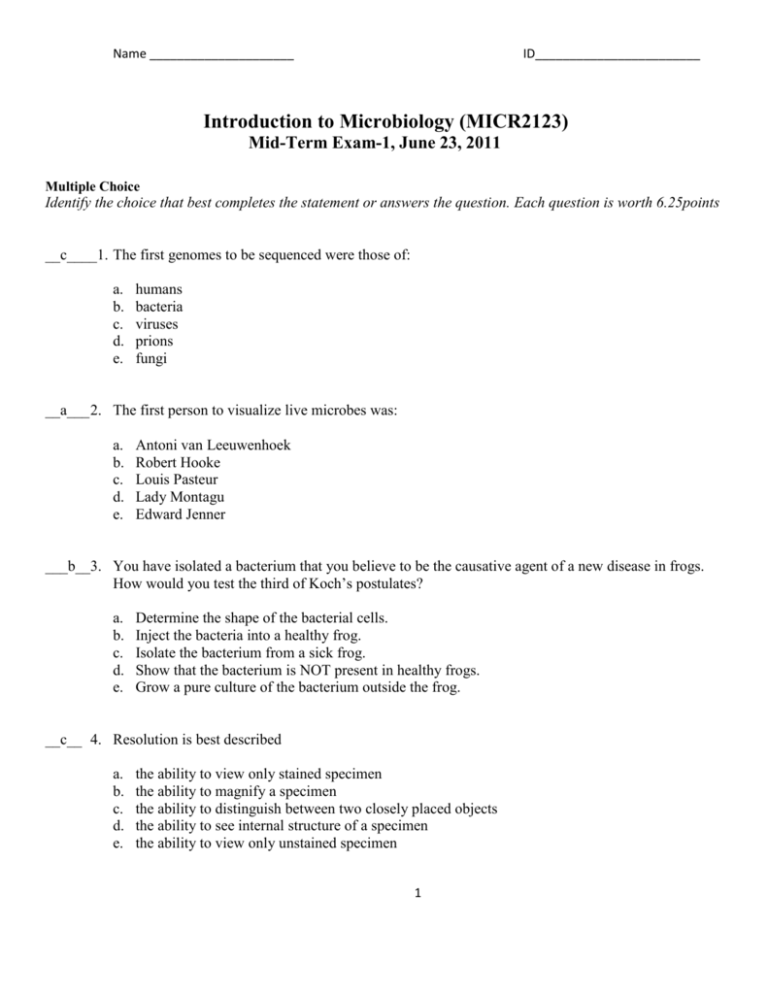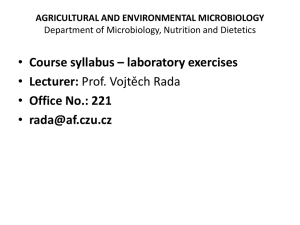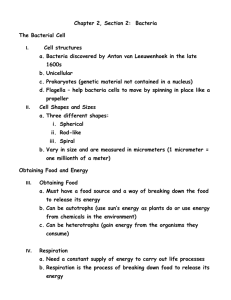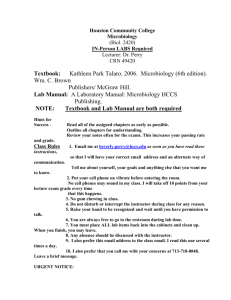Microbiology Exam: Cell Structure, Growth, and Metabolism
advertisement

Name _____________________ ID________________________ Introduction to Microbiology (MICR2123) Mid-Term Exam-1, June 23, 2011 Multiple Choice Identify the choice that best completes the statement or answers the question. Each question is worth 6.25points __c____1. The first genomes to be sequenced were those of: a. b. c. d. e. humans bacteria viruses prions fungi __a___ 2. The first person to visualize live microbes was: a. b. c. d. e. Antoni van Leeuwenhoek Robert Hooke Louis Pasteur Lady Montagu Edward Jenner ___b__3. You have isolated a bacterium that you believe to be the causative agent of a new disease in frogs. How would you test the third of Koch’s postulates? a. b. c. d. e. Determine the shape of the bacterial cells. Inject the bacteria into a healthy frog. Isolate the bacterium from a sick frog. Show that the bacterium is NOT present in healthy frogs. Grow a pure culture of the bacterium outside the frog. __c__ 4. Resolution is best described a. b. c. d. e. the ability to view only stained specimen the ability to magnify a specimen the ability to distinguish between two closely placed objects the ability to see internal structure of a specimen the ability to view only unstained specimen 1 Name _____________________ ID________________________ ___a__ 5. If an object and its surroundings absorb or reflect radiation equally then the object will be: a. b. c. d. e. undetectable reflected refracted radiated Fluoresced ___a___6. Three cells with generation times of 30 minutes are inoculated into a culture medium. How many cells are there after 5 hours? a. b. c. d. e. 3072 1024 243 48 16 __a____7. With the 100 x lens, the refractive index of light passing through the specimen is maintained by insertion of __________, with a refractive index comparable to that of glass. a. b. c. d. e. immersion oil water air bacteria stain ___a___8. The __________ in the Gram stain process binds to the crystal violet, generating a complex that is held more tightly within the cell. a. b. c. d. e. mordant safranin alcohol bacteria slide __c__ 9. Which type of microscopy is particularly useful in studying the internal structures of a cell? a. atomic force b. SEM 2 Name _____________________ ID________________________ c. TEM d. dark-field e. bright-field __a___10. __________ reinforce and stiffen cytoplasmic membranes in bacteria. a. b. c. d. e. hopanoids polyamines sterols peptidoglycans lipids __b___11. Functions of the cytoplasmic membrane include all of the following EXCEPT: a. b. c. d. e. permeability barrier assemble proteins home to many important proteins transport structural support __b___12. All archaeal phospholipids have a/an __________ link between glycerol and the lipid component. a. b. c. d. e. ester ether ethanolamine unsaturated phosphatidyl __d___13. Which is NOT a component of any bacterial cells wall? a. b. c. d. e. peptidoglycan techoic acids N-acetylmuramic acid cellulose L-lysine __c___14. All of the following are components of peptidoglycan EXCEPT: a. N-acetylglucosamine b. N-acetylmuramic acid 3 Name _____________________ ID________________________ c. lipopolysaccharide d. amino acids e. peptide cross-links __c___15. One of the following staining techniques will help identify bacteria that have a thick, waxy-layer in their cell wall (e.g. Mycobacterium. sp) a. b. c. d. e. Gram staining capsule staining acid-fast staining endospore staining flagella staining __c___16. Lipopolysaccharides are found in: a. b. c. d. e. all bacteria Gram-positive bacteria Gram-negative bacteria archaea eukaryotes _e____17. The increased stability of __________ supercoils in archaea allows them to grow in more extreme environments. a. b. c. d. e. extra negative no flexible positive __a__18. Fts proteins do which of the following? a. b. c. d. e. form a ring in the area where cell division will occur aid in DNA replication are involved in peptidoglycan synthesis are involved in making proteins are important in transcription ___b__19. Which name refers to having flagella attached at one or both ends of the cell? a. peritrichous b. lophotrichous 4 Name _____________________ ID________________________ c. monotrichous d. pili e. flagellated __c___20. Bacterial movement in response to a chemical gradient in the environment is called: a. b. c. d. e. phototaxis aerotaxis chemotaxis anytime taxi haptotaxis ___e__ 21. Which of the following is a micronutrient? a. b. c. d. e. carbon nitrogen sulfur calcium zinc __c___22. All of Earth’s life-forms are based on: a. b. c. d. e. hydrogen nitrogen oxygen carbon Phosphorus __c___23. An organism that obtains energy from the light and carbon from an organic compound is called a: a. b. c. d. e. photoautotroph chemoautotroph chemoheterotroph photoheterotroph lithotroph __b___24. Which of the following proteins represents a coupled transport system where two molecules travel in the same direction? a. aquaporin b. symport 5 Name _____________________ ID________________________ c. antiport d. porin e. diffusion transporters __a___25. When the intracellular iron concentration is low, iron-scavenging molecules called __________ are produced. a. b. c. d. e. siderophores endospores heterocysts mycelia quorum sensors ___c _26. All of the following are true about MacConkey medium except: a. b. c. d. e. it is selective. it is differential. it is both selective and differential. it contains bile salts. lactose fermenters appear colorless. __a___27. __________ intercalates between DNA bases, causing dead cells to stain red under a fluorescence scope. a. b. c. d. e. propidium iodide Syto-9 ethidium bromide crystal violet safranin __b___28. Which of the following is the best technique for counting only viable cells? a. b. c. d. e. direct microscopic count spread plate spectrophotometer chemostat dry weight measurements 6 Name _____________________ ID________________________ __b___29. A cafeteria worker who fails to wash his hands thoroughly and fails to wear gloves inoculates a quiche with 4 E. coli when he uses his finger to test whether it is done. By the time you purchase the quiche, there are 128 E. coli cells in it. How many generations did the cells go through? a. b. c. d. e. 4 5 8 32 64 __a___30. During biofilm formation, as more and more cells bind to the surface, they begin sending signals to each other in a process called: a. b. c. d. e. quorum sensing homoserine lactone siderophores polysaccharides symbiosis ___a__31. Some bacteria form environmentally resistant forms called __________. a. b. c. d. e. endospores heterocysts colonies hyphae actinomycetes __b___32. How do some cyanobacteria fix nitrogen while growing aerobically? a. b. c. d. e. they don’t because nitrogenase is destroyed by oxygen by using special cells called heterocysts that protect the enzyme by using cysts that protect the enzyme they just do it, no special structures or mechanisms they live symbiotically with other organisms that protect the enzyme ___a__33. Which of the following are used to assess which genes are expressed to make RNA in a given organism at a given time or under a given condition? a. DNA microarrays b. PCR 7 Name _____________________ ID________________________ c. DNA sequencing d. fluorescence microscopy e. viable cell counts __c___34. Human pathogens are: a. b. c. d. e. halophiles psychrophiles mesophiles thermophiles extreme thermophiles __b___35 . Psychrophiles favor the cold since their membranes are more fluid at low temperature owing to the high proportion of __________ present. a. b. c. d. e. saturated fatty acids unsaturated fatty acids lipopolysaccharides transport proteins water ___e__36. __________ grow at temperatures as high as 110°C, which occur under extreme pressure. a. b. c. d. e. thermophiles extreme halophiles psychrophiles hyperpsychrophiles hyperthermophiles __a___37. What percentage of microbes in our biosphere can be cultured in the laboratory? a. b. c. d. e. less than 10 % approximately 20% approximately 25% approximately 50% more than 90% __c___38. Which century is known as the golden age of microbiology? a. the seventeenth b. the eighteenth 8 Name _____________________ ID________________________ c. the nineteenth d. the twentieth e. the twenty-first __d___39. Which group of microorganisms includes many that grow in extreme environments? a. b. c. d. e. ___a___40. algae bacteria protists archaea fungi Which of the following pairs is mismatched? fluorescence microscopy –uses fluorescent light source bright-field microscopy –used to view stained specimens confocal microscopy-produces 3-D image electron microscopy- allows to view specimen that can’t be seen in light microscopes e. scanning electron microscopy-allows to view surface details of the specimen a. b. c. d. 9 Name _____________________ ID________________________ 10









